View current page
...more recent posts
Tools and Media: Arcangel, Maeda, Salavon, Friedman
In the comments to a previous post, twhid made a distinction between the computer as a medium and the computer as a tool, which prompted me to discuss a work by John Maeda that I believe fails as both, as contrasted with Cory Arcangel's famous Nintendo Clouds piece, which succeeds as medium, tool, and content all rolled into one. And I also talked about Tom Friedman's and Jason Salavon's work. This post is a revised, expanded version with pictures. twhid's comment:
Perhaps people are confusing these two things: are you using the computer as a tool or as the medium?And my repl(ies):
When your friend states "the resulting visual product is what matters." This means he's using the computer as a tool to a visual end. In this sense it doesn't matter, he could be using a pencil or camera or computer or eggplants to get whatever sort of visual "product" he's after.
But if one is using a computer as the MEDIUM (not simply a means to a visual end) then it seems one should have an understanding of that medium. And it's arguable that to understand a computer as a medium you really need to be able to program it.
Then of course we can start talking about using computer networks as a medium... :-)
I've been trying to keep the discussion confined to computer-made art that winds up in the "gallery discourse," or what's left of it. The use of programming in network-based art I consider a slightly different topic. As an example of the former, what is Cory Arcangel "after" in his Nintendo Clouds piece? If it's a big Barnett Newman field he probably could use eggplants (or blue squid ink) to make it. But it's more than that--it's a work where the computer is the tool, the medium, and (at least partially) the subject matter. It works on a pure visual level (a big expanse of seductive blue with wry found imagery), as a medium (the hacked cartridge as ambient video), and has something to say to hackers and non-initiates alike about the malleability of (digital) reality, through the subtraction of information from familiar game iconography. Whether someone could arrive at something that successful without a stitch of programming knowledge is one of the questions I'm asking.
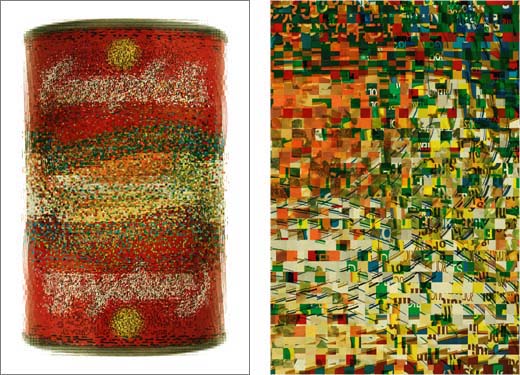
A piece that fails on all these levels is the above cibachrome print from 2002 by John Maeda, where he digitally sampled "all the Campbell's soup cans Warhol used" (as one review phrased it) and made a kind of iterative, vibrating composite. No doubt he did his own programming to realize this, but Tom Friedman, at Feature Gallery, had famously achieved a similar visual effect with a probabilistic dollar bill a couple of years before, using scissors and sheer patience. Friedman's was a well known piece in the art world, an analog design that evoked digital processes. Below is just a detail--the entire dollar is done like this, using actual cut up bucks, so the piece is about three feet long:
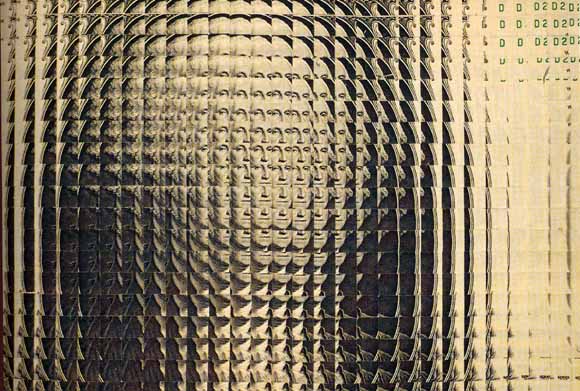
The subtle gradations between image "steps" are very trippy and disorienting, ditto seeing the familiar paper moneystuff on such a large scale. A similarly done self portrait by Friedman is online here (scroll down). As the accompanying text explains it, "Friedman dissected and re-configured 256 small, identical passport-style photographs into a large abstract self-portrait. The individual self-portraits were cut into 1/4-inch grids based on a series of nearly imperceptible 1/64-inch deviations. The 33,072 resulting squares were arranged, one by one, to create a large magnified, out-of-focus mosaic of the original image."
Maeda's soup can doesn't stretch in space but has the same hazy, micro-composite shimmer as Friedman's cut-up projects. (I don't actually consider Friedman's to be digital work, I bring it up to provide a context that previous discussion of the can has lacked.) Conceptually, and even more damning, the can is derivative of Jason Salavon, who has been making similar visual composites for years, through computer-derived averaging of like images (class pictures, Playboy Playmates, etc.) (And before Salavon, Nancy Burson...) Choosing Campbell's soup as subject matter is supposed to be "deconstructing" Warhol, one guesses, but it's a hackneyed reference. Both Salavon and Friedman know recent art history and the approximate place their work fits into it, whereas Maeda is a designer with art aspirations who admits to not following contemporary art (scroll down). Yet Maeda is showing at the London ICA and the Fondation Cartier as an artist, for reasons I don't entirely fathom (at least according to his 2002 catalog--I can't find any online reference to those shows, supposedly scheduled for 2003 and 2005, respectively).
Other Maeda work is here (I like 1, 2, and 4 but then he starts to lose me). And below is another Friedman piece that puts the can to shame. It is not out of focus; it's actual cereal boxes cut up the same way the dollar is above:
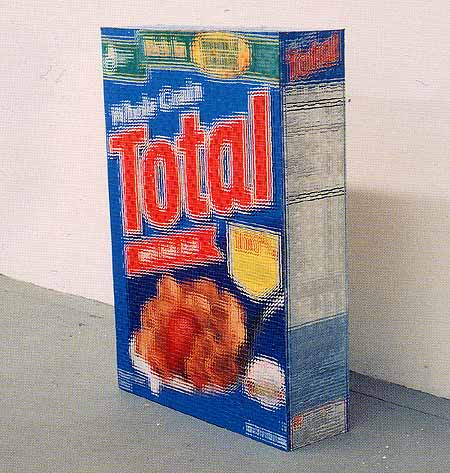
Update, December 2005: The links above to the Maeda pieces on the Cristinerose website are dead, sorry. Maeda's work did in fact get shown at the Fondation Cartier.
Update, 2011: Maeda "Food" catalog reposted as PDF
More on the Republican Spin Point Du Jour
For Pat Buchanan, the problem with "lesbian" is not that it's salacious but that it's a "cold, hard word," and Kerry's use of it is like "saying ... 'my friend's daughter had an abortion.'" What a delicate flower he is. So, it's the word, combined with people only half-following politics that think Kerry outed Mary Cheney, that's the source of the "outrage."
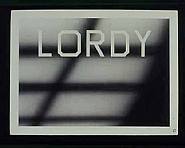
Ed Ruscha, Lordy,1991, acrylic on paper, 30 x 40.2 inches
Artist vs Programmer: How Low Can You Go?
Saying the "artist vs programmer" discussion is "stupid" (I agree, and I can only take so much of this), my friend David asks:
How low level can one go in this contest...
... did the artist develop the "language" they used to write the program to produce the art...
... did the artist write the compiler which compiles the program into machine code which runs the program which displays the art....
... did the artist build the computer which was used to write the program and run the program...
... did the artist build the components for the computer which was used to write the program to ....
... did the artist manufacture the materials used to fabricate the components used for the computer....blah, blah, blah.
IMHO, it shouldn't matter if the artist is a programmer or not, it is the resulting visual product which matters (unless the artist is into "process" art so in this case, they get all anal about the endless details of how they made such and such widget art object. But then they are really just technicians, much like print makers who only can talk about hand making their own papers from grandma's antique but stained linen bedsheets and using exotic inks made from virtually extinct sea mammals).
FWIW, many programmers feel they are artists as well. They write "elegant," sparse, and minimal code with individual "style." Their code is their art, much akin to poetry.
Pre-developed software is a tool, so are programming development languages. They both are tools which can be used as a means to do interesting things.
I try not to watch any more TV news than I have to, but I gather from the blogosphere ripples that the cable gasbags are going on about John Kerry's use of the word "lesbian." This is just rampant homophobia, and its real purpose is to deflect attention from what we all saw and heard the past couple of weeks, which was John Kerry kicking George Bush's unprepared, possibly medicated ass all over the states of Florida, Missouri, and Arizona. Said gasbags love George Bush, and they've been talking up his assured victory until it became abundantly clear to everyone in the world that when placed side by side with an actual grownup with no handlers to help him (except through that earpiece, which he used poorly) he is by far the lesser qualified candidate. How about that spit at the corner of his mouth in the third debate? And that weird phony smile? Because I haven't been cattle prodded into thinking about the latest faux controversy, those images of a bad dude in free fall are still burned into my mind.
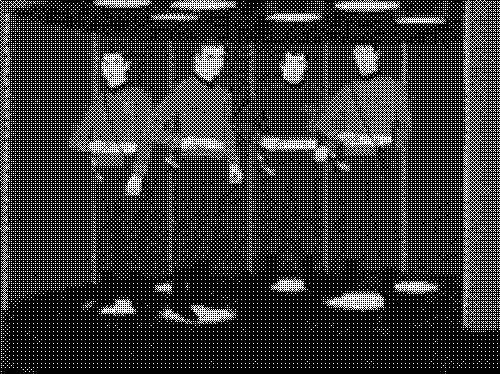
.GIF by jimpunk (from SCREENFULL - always something good going on over there).
More on the coding vs artmaking question. In the comments to an earlier post, Mark contributes these thoughts about imaging and how much can or should be left to humans:
In the process of developing video systems, I've accidentally introduced a variety of bugs that create interesting and unusual visual effects. Often an understanding how the visual and the implementation are tied together has helped me to quickly understand how to correct the implementation to make the effect go away.And my reply:
It seems that going the other way -- understanding how to modify the implementation (sw, hw, algorithms) to create effects -- would give someone more "knobs," more control, more flexibility. But of course, knowing what to do with that flexibility is all the difference.
Something I don't know how to gauge is how much power is needed. I'm amazed by what artists can do with simple tools. I think I would need MatLab to draw a decent sphere.
Some people don't think drawing contributes anything to the arena of so-called advanced art (as that concept originated in the art galleries and continues in new media) while others value it far too much--e.g. the underground economy of painting that thrives in the back rooms of even so-called conceptual galleries, based on supposed authenticity of hand skill. I think the cognitive and perceptual processes associated with drawing have some role to play as art makes its transition from the vine charcoal to the 1s and 0s phase. I really can't say what or why (not succinctly anyway) other than to say that I'm enjoying continuing to draw in a field where no one can tell whether it's computer-assisted or not. (The same comments would apply to anyone with skill on a musical instrument.)
But Mark's comment makes a pretty good case for knowing some code. The problem is up to now artists and musicians have relied on technicians to develop the "knobs," and only after a product is introduced do they get to say which knobs have the potential to expand the visual/audial landscape and which are silly, soon-to-be-dated effects. Unfortunately, to date too many of the artists who code also make crappy art--and I'm talking here mostly about stuff that finds its way into galleries, as opposed to net art that is more "about" coding. The best work is happening at the low-fi end, with the BEIGE crew, say, or the music of Paul Slocum (a post about him soon). Even in Net Art, the most interesting stuff to me is often simple html, GIFs, etc.
I was watching for signs of "the wire" in Pres. Bush's (crappy) debate performance last night. Definitely noticed he had a tendency to look down and to the right, silently, and then pop back up with a statistic or line of argument. Salon got another TV camera screen shot showing the bulge under his jacket. It appears, folks, our President is a cheater. Surprisingly, the
"Top 10 President Bush Explanations For The Bulge In His Jacket:"UPDATE: Text revised after dave reminded me that CBS isn't owned by a defense contractor. That we know of.
10. "It's connected to an earpiece so Cheney can feed me answers--crap, I wasn't supposed to say that."
9. "It's a device that shocks me every time I mispronounce a word."
8. "Just a bunch of intelligence memos I haven't gotten around to reading yet."
7. "Mmm, delicious Muenster cheese."
6. "John Kerry initially voted for the bulge in my jacket, then voted against it."
5. "I'll tell you exactly what it is--it's a clear sign this economy is moving again."
4. "Halliburton is drilling my back for oil."
3. "Oh like you've never cheated in a presidential debate."
2. "Accidentally took some of Governor Schwarzenegger's 'roids."
1. "If Kerry's gonna look like a horse, then I'm gonna look like a camel."
UPDATE 2: According to Dave Lindorff, who's been covering this story for Salon and Counterpunch, the Letterman Top 10 is emblematic that the media intends to treat this story as a joke. The US media, that is. Lindorff says he was interviewed for an extensive story on Bush bulge that ran on international CNN but not in America.
